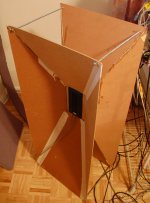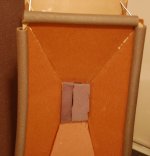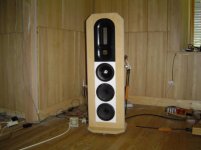for a resin, try envirotex. easy to get, dries glossy and very hard.
surfers also use some sort of epoxy resin to make boards, but it is pretty expensive, and probably nastier.
surfers also use some sort of epoxy resin to make boards, but it is pretty expensive, and probably nastier.
I built just one speaker to test.
http://img252.imageshack.us/img252/2179/cimg1391dm0.jpg
that waveguided OB sounds too puny in comparison to other speakers i have. with the space it takes it has to sound better. so the next step is to convert it to some sort of unity horn...
http://img252.imageshack.us/img252/2179/cimg1391dm0.jpg
that waveguided OB sounds too puny in comparison to other speakers i have. with the space it takes it has to sound better. so the next step is to convert it to some sort of unity horn...
Hi MisterTwister,
How does this wave guide sound with the Neo8?
I've been wanting to build a Neo8 project and have been looking or an interesting design.
How does this wave guide sound with the Neo8?
I've been wanting to build a Neo8 project and have been looking or an interesting design.
I have not done any critical listening. As I remember from last time I listened, they have strangely bright sound, even with foam in place. Manufacturers' paper says "these planar transducers do not have cone break-up resonance with associated distortion"
I think that's not true, that transducer clearly adds sound of it's own. I think it needs to be crossed over to a small tweeter around 3k.
I think that's not true, that transducer clearly adds sound of it's own. I think it needs to be crossed over to a small tweeter around 3k.
finally I found use for these, with neo8 drivers.
measurements with and without foam at 2ft from baffle edge.
highpass filter is not used.
I've seen this done before, and it's not the best way to go. The round needs to be on the outside of the flat section, not inside. It should act as a smooth transition from the wall-defined pattern to free air, not an obstruction at the edge. You're using closed-cell foam, which is effectively a solid. Open cell would be less of a problem here, but still better to have it be outside the planes formed by the horn walls.
Here are a picture of my dipole speakers with waveguides for both the super tweeter (AMT) and midrange / tweeter (AMT) - the three 8" drivers operates from 300Hz and down.
This kind of shapes works as waveguides.
you're operating AMTs as low as 300Hz? (brave man methinks)
you're operating AMTs as low as 300Hz? (brave man methinks)
As I have designed them they run flat down to 100Hz and I run them all the way down in a backloaded horn where they are extended to 60Hz flat and 30Hz usable..
Used as fullrange (with one unit) I am limited to 80 - 85 dB in the listening position due to xmax - crossed at 300Hz 6dB/oct there are no practical xmax limit....
Here are a picture of my dipole speakers with waveguides for both the super tweeter (AMT) and midrange / tweeter (AMT) - the three 8" drivers operates from 300Hz and down.
This kind of shapes works as waveguides.
What's the big AMT?
- Status
- Not open for further replies.
- Home
- Loudspeakers
- Full Range
- waveguided open baffle



